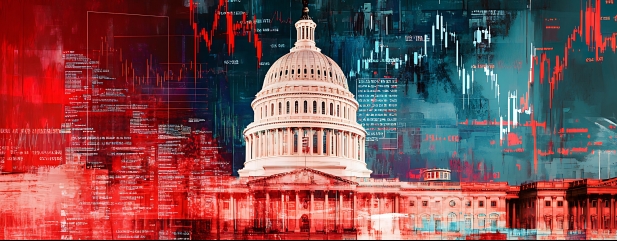Archived article
Please note that tax, investment, pension and ISA rules can change and the information and any views contained in this article may now be inaccurate.
Bond vigilantes bare their teeth as US long-term yields rise

Eagle-eyed investors may have noticed something strange going on at the long end of the US treasury market, where 30-year yields recently breached 5% to reach their highest level since 2007.
This may sound counter-intuitive given the Federal Reserve started cutting official interest rates in September 2024 in response to cooling inflation. After peaking at 5.5% The Fed has lowered interest rates by a full percentage point to 4.5%.
Market implied interest rates suggest the Federal Reserve will remain on hold until September 2025, then lower short-term rates by another percentage point by the end of the year, although the market remains volatile.
Yet since the Fed’s rate cutting cycle began, 10-year treasury yields are roughly three quarters of a percentage point higher at 4.5% and 30-year yields are a full percentage point higher at 5%.
There are several factors which can influence longer-dated bond yields, but consensus suggests the two most important are medium-term inflation expectations and worries over persistent and rising national debts.
In other words, investors in long bonds are demanding a ‘term premium’ to compensate them for the risk inflation remains sticky and the likelihood of more bonds being issued to finance increasing government debt.
Investors looking for evidence of tariff-induced inflation in the May CPI (consumer price index) report on 11 June were disappointed after the print came in lower than expected at 0.1%, which suggests US companies are absorbing some of the impact in their margins.
On an annual basis, inflation ticked up to 2.4% from 2.3% in the prior month. Less encouraging for the Fed was an uptick in ‘super core’ inflation, which takes services inflation minus shelter (housing) costs.
With Donald Trump’s ‘Big Beautiful Bill’ making its way through Congress, potentially adding trillions to the national debt, and the government running a 6.5% budget deficit at a time of full employment, some prominent investors have sounded the alarm.
Speaking at the Bloomberg Global Credit Forum on 12 June, Doubleline Capital chief executive Jeffrey Gundlach warned of ‘a reckoning’ for US debt, which he believes has become ‘untenable’ and may lead investors to move out of dollar-based assets.
Jamie Dimon, head of JPMorgan Chase (JPM:NYSE), has also warned the bond market will ‘crack’ if the government doesn’t get a grip on the deficit.
US treasury secretary Scott Bessent, on the other hand, insists rising bond yields reflect the view the US economy could see an acceleration in growth driven by deregulation and tariffs.
The problem is, higher long-term yields push up the cost of financing, and for the first time in its history, last year the US spent more servicing its debt ($881 billion) than on defence ($850 billion).
Important information:
These articles are provided by Shares magazine which is published by AJ Bell Media, a part of AJ Bell. Shares is not written by AJ Bell.
Shares is provided for your general information and use and is not a personal recommendation to invest. It is not intended to be relied upon by you in making or not making any investment decisions. The investments referred to in these articles will not be suitable for all investors. If in doubt please seek appropriate independent financial advice.
Investors acting on the information in these articles do so at their own risk and AJ Bell Media and its staff do not accept liability for losses suffered by investors as a result of their investment decisions.
Issue contents
Feature
Great Ideas
News
- Recruitment firm Robert Walters falls to post-pandemic low
- Renold shares jump above offer price on speculation of a rival bid
- Bellway update has helped lift the gloom towards housebuilders
- FedEx guidance will be under scrutiny after back-to-back profit downgrades
- Crude surges from multi-year lows on Iran-Israel tensions
- Gaming stocks enjoy revival as Nintendo Switch 2 is launched
 magazine
magazine








